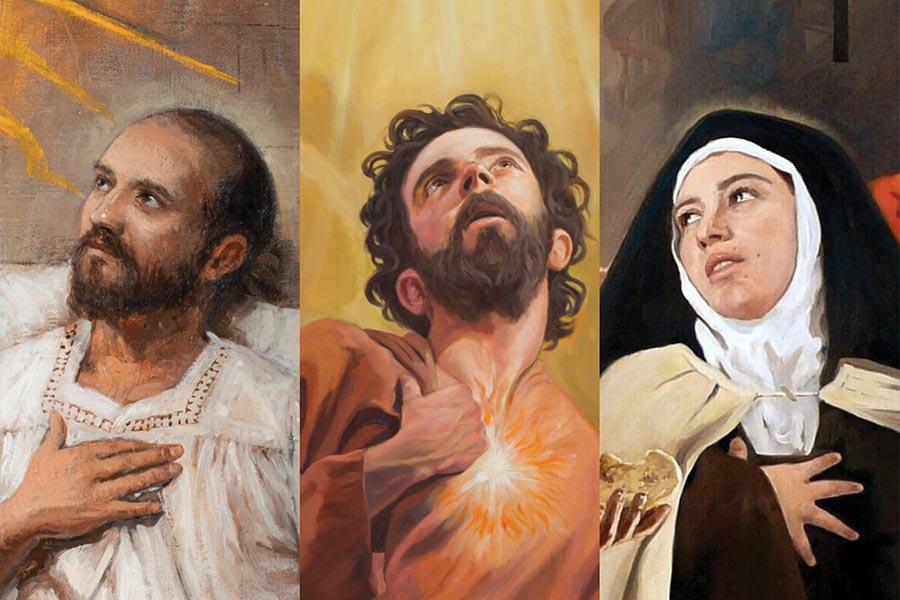Stars of holiness: how the godly examples of five saints help us today

From left, Saint Ignatius of Loyola, Saint Philip Neri, and Saint Teresa of Avila. (artwork by Raul Berzosa)
This year marks the celebration of the 400th anniversary of the sainthood of Saint Ignatius of Loyola, Saint Francis Xavier, Saint Teresa of Ávila, Saint Philip Neri, and Saint Isidore the Labourer, whose joint canonization ceremony was presided over by Pope Gregory XV on March 12, 1622, at the Vatican. Through this celebration, we commemorate not only their surrender to God but also opportunities that arise to recognize and implement their teachings in our daily lives, even in the small, most minuscule of things.
“Holiness is possible,” says Lupita Hernández, Ministry Coordinator at Cristo Rey Catholic High School in Fort Worth. A final goal of being saints is "seeking to please God from the moment we wake up." Further, she points out the spiritual growth that has led her to attend, at least once a year, the silent retreats in the Montserrat Jesuit Retreat House, the legacy of Saint Ignatius.
“Saint Ignatius focused on the good, to make it much better. That is very inspiring,” said Hernández, who serves in different diocese parishes during Holy Hours, talks, and retreats. "Ignatian spirituality allowed me to feel God fully," she said, explaining that his teachings taught her to "seek God in everything."
Hernández acknowledges that a silent retreat can be "challenging for the Hispanic community," but she is happy that "increasingly, there is a greater participation of Hispanics in these retreats."
Jesuit Retreat Centers, such as Montserrat House, exist thanks to the teachings of Saint Ignatius of Loyola, pointed out Father Tony Rauschuber, SJ, Director of the Montserrat Jesuit Retreat House. The spiritual exercises that Saint Ignatius wrote in the cave of Manresa, Spain, are the ones that are taught and used in retreats to create "a time of prayer, Eucharist, and silence with God." The duration of the retreats varies from three to 30 days. There are more than 25 Jesuit retreat houses in the United States, and the one in Lake Dallas, on the border of the Diocese of Fort Worth, is the only one in Texas, where four retreats are held in Spanish each year.
“Saint Ignatius of Loyola was a person of prayer and is the founder of the Jesuits, which is the largest religious order in the world today,” Father Rauschuber explains.
Paola Quintero-Araújo, assistant director of pastoral formation of permanent deacons, pointed out that the biggest blessing we can wish for is not professional success or the glory of this world but the glory of eternal life, "because once we win heaven, everything else follows without any obstacles,” she pointed out, inspired by her devotion to Saint Ignatius of Loyola.

After delving into his teachings and living the spiritual exercises of Saint Ignatius for 30 days, Quintero-Araújo implements and values the teachings of Ignatian examen daily, which is "to become aware of the presence of God every day, to help identify the opportunities lost while feeling His presence, put forth the difficulties that prevented it, and to be a better person the next day,” explained Quintero-Araújo.
Saint Ignatius “teaches us that everything we do is for the greater glory of God. We must acknowledge the presence of God in our lives and surrender our lives to Him,” described Quintero-Araújo, a graduate of the Pontifical Xavierian University of Bogota, Colombia, which is a Jesuit University.
Being contemporaries, "important connections" existed between Saint Ignatius of Loyola, Saint Francis Xavier, Saint Philip Neri, and Saint Teresa of Ávila, noted Father Joe Tetlow, SJ, who is also at Montserrat House.
Saint Francis Xavier, who belonged to “The Society of Jesus” (also known as the Jesuit Order), wrote many letters that he sent to Saint Ignatius during his long missions to Portugal, India, Morocco, and Japan. These letters were copied by the Jesuits and read to their students. These teachings helped to motivate hundreds of people to stay within the Catholic Church and hundreds more who joined the Jesuit Order. These letters have "valuable influence," stated Father Tetlow.
Saint Francis Xavier taught in his missions that we show that Jesus Christ is Our Lord by how we live and look forward to eternal life. This is something that “each of us has to recognize during our days,” affirmed Father Tetlow on the example of the “Patron of the Missions.”
Saint Philip Neri was born in Italy and founded the Congregation of the Oratory. However, according to Father Tetlow, he was to be a Jesuit, but Saint Ignatius observed his capability to be the leader of his own priestly order and recommended it to him. Saint Philip Neri "did it and became a saint," he added.
Father Tetlow explained that Saint Teresa of Avila was very grateful that two young Jesuit priests helped her learn from the Scriptures.
Saint Teresa of Ávila “was an enterprising woman, with a strong disposition, very diplomatic and devoted to Saint Joseph and Our Lady. She loved the Church extremely and always wanted the best for the Holy Mother Church,” said Juan Rendón, Director of the Diaconal Formation for the Diocese of Fort Worth.
Rendón understands "the charism of prayer" of Saint Teresa of Jesus well, as she is also known, since he has been a member of the Secular Order of Discalced Carmelites for six years and lives "the Discalced Carmelite life."

Saint Teresa reformed the Order of Discalced Carmelites, not only for nuns and friars but also for lay people committed to the evangelizing mission of the Church.
"The 'wanderer saint' did not stop evangelizing by founding mere convents," Rendón added, because "she longed for a place of contemplation that reflected the life of Mount Carmel, of mountains, the desert, and simplicity." She reformed Carmel and changed its name to the “Discalced Carmelites.” Saint Teresa saw convents as “oases of prayer…to consecrate the world through prayer.” The Discalced Carmelite Monastery was established in the Diocese of Fort Worth in 1958, headquartered in Arlington since 1984.
Rendón describes her as a "teacher of prayer" and points out that Saint Teresa shows us the path to find "the balance between prayer, contemplation, and action."
"The Lord walks with us even in the midst of the simplest of things, and that is where He wants one to work," he said, echoing the teachings of Saint Teresa. "She teaches us to recognize the most sacred humanity of Our Lord to value His sacrifice and His love," Rendón added.
Pope Saint Paul VI proclaimed her a Doctor of the Church in 1970. Saint Teresa of Jesus was the first woman recipient to receive this title.
Saint Isidore the Labourer, patron saint of Madrid and farmers, is the only one among these four canonized saints who was a layman and was named a saint almost 500 years after his death. Saint Isidore worked the land throughout his life and always put God first in his life. He achieved sainthood because of his incredible dedication, trust, and deep faith in God.
